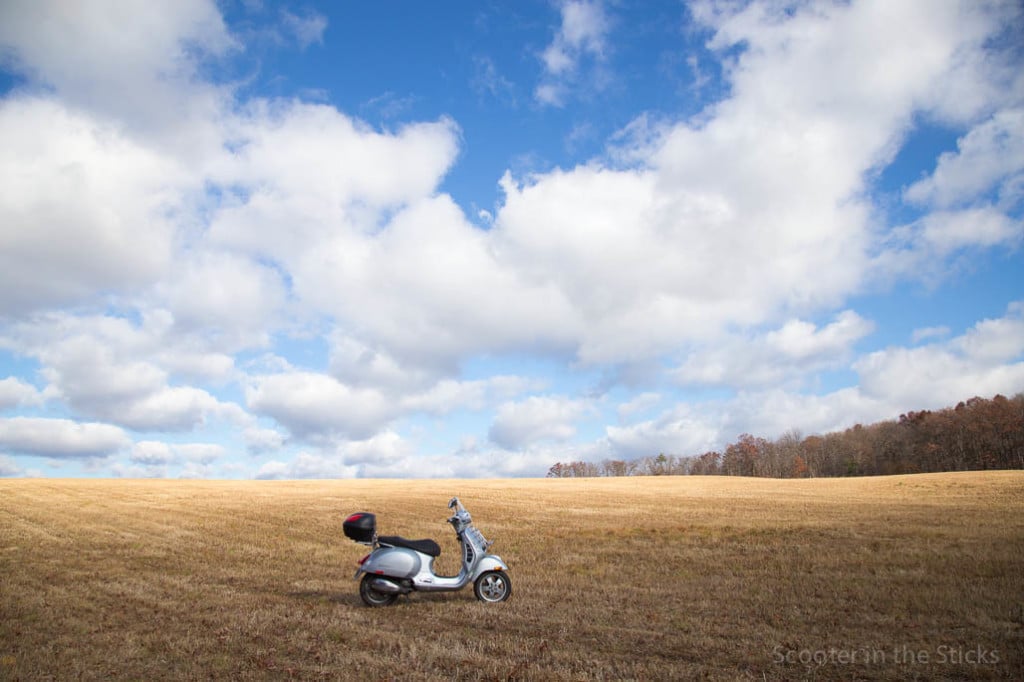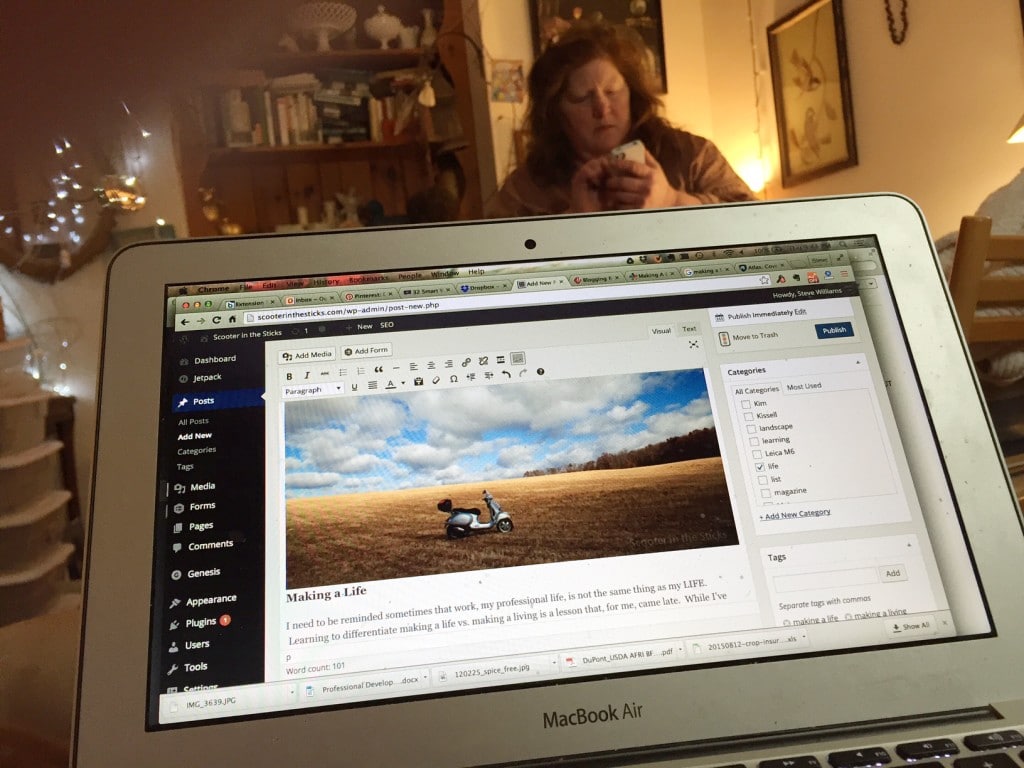 Making a Life
Making a Life
I need to be reminded sometimes that work, my professional life, is not the same thing as my LIFE. Learning to differentiate making a life vs. making a living is a lesson that, for me, came late. While I’ve always considered myself fortunate that I’ve always loved the work I do and the challenges it presented. Riding the Vespa added a point of view from which I could see the difference between the energy invested in making a living and what I did making a life.
Family and friends — they’re components of a life that are like treasure.
 Life Within Reach
Life Within Reach
Just a few feet away my wife writes a text message to her sister about our dog Lily becoming a woman — her first heat. Life is always spinning and calling, sometimes at a distance and others right in front of me. When work is added to the mix it can grow more complicated.
 Once a Photographer, Always a Photographer
Once a Photographer, Always a Photographer
When asked what I do for a living I almost automatically think first — photographer. That answer is fueled by a desire for something easy to understand and long years of use. But the reality is I’m not a professional photographer anymore. Just an enthusiastic amateur.
This picture was made a couple years ago on assignment — an environmental portrait of three students who were building a portable food production system out of old truck bodies. I can always gauge whether a photo shoot was successful if I can get the art director to buy in enough to hold a reflector.
 Magazine editor
Magazine editor
Until the end of December I was also the editor of Penn State Ag Science magazine — a twice a year publication of the College of Agricultural Sciences at Penn State. It was one of the more enjoyable aspects of my professional life affording me exceptional access to a wide range of people and projects and creating what I would offer regard as being a professional tourist.
I pasted the spreads of the first issue I edited on the wall of my office at the insistence of the art director. As each new spread arrived from design I stuck it on the wall. As he suggested, I was able to recognize a rhythm from page to page (or lack of one) and begin to see how content work together across the entire issue. I’m fortunate to have always been able to work with people who knew more than I do. Makes learning fast and fun.
Not long after becoming editor I was also made Associate Director for Public Relations and Marketing. A position I held until the end of December 2015.
 Enter ATLAS
Enter ATLAS
This morning a colleague made this picture for me. There are large posters in our conference room of some of the products produced for the college — magazines, advertisements, posters — things that reflect the public relations and marketing activities of our unit. Products I had the good luck to be part of. Looking at the magazine cover I recall two goals I set for myself — be a representative for our readers, not the college. And always surprise people with the depth and breadth of agricultural sciences. It’s not always what you think it is.
For the past couple years I’ve been doing two jobs. The PR and marketing tasks, and overseeing development of a new, non-credit online course development team for Penn State Extension. And that bit of business grew from an idea of a colleague that has become what we call the ATLAS Project. At the end of December I shed the role of editor, photographer, and leader of the PR and Marketing team to become the Assistant Director for Digital Education.
Expanding Access and Reach to Information
ATLAS is a complex project conceptually and technically. The video helps explain the scope.
ATLAS reaches across a wide range of people and processes to do one basic thing — expand the access and reach of the educational resources and opportunities of Penn State Extension. Traditionally, extension engaged people in face-to-face interactions — in workshops, during farm and home visits, and a range of other personal connections with customers. But as expectations grew by the legislature and others that model wouldn’t be enough. The online experience had to be added to the mix.
Think of ATLAS as an umbrella under which lives CRM (a massive new database for customer relationship management), digital strategy (a customer focused web experience including marketing automation and e-commerce), and product strategy (the educational product line by which we’ll connect with customers — face-to-face or online). That’s where I come in.
My new position, aside from a role in the overall development of ATLAS, is focused on online course production. My team consists of twelve people working hard to transition educational opportunities that exist as face-to-face courses and workshops to an online experience. There are 26 courses in active production, about as many on deck, and almost 130 total identified for production. Later this summer when ATLAS is scheduled to launch our goal is to have 50 or 60 courses complete and in our edX learning management platform.
Makes my head itch thinking about the work left to be done. Like a ride on the Vespa in winter weather, it’s an exciting challenge. I’m lucky to have the opportunity to participate in something like this and be able to say, “That’s my job”.
And that’s the challenge to — balancing making a life vs. making a living.
It’s a full time job…
I enjoyed the ATLAS animation!
So who was the talented sketch artist?
What your group is doing is playing out in many other locations around the world.
The on-line distribution of (extension) courses once taught in a lecture hall or classroom will NOW be experienced on one’s own device, be it stand-alone or laptop style of computer, or a form of tablet hand-held reading device including cell (mobile ) telephones, and related. It will mean too a more informed consumer of product produced by Penn State as an educational institute.
And would expect the entire plethora of Penn State extension courses could well, over time be taught in this manner. Next up if not already in situ, daily courses. IN theory one could take their entire extension course on-line and never enter the main campus; connecting to the smaller regional campus areas in the State of Pennsylvania.
So yes, attempting to distinquish between your working life and your on-line Vespa life, and too if I may add, your other life including famiy including the requirements of day to day life all mix together to form you, Steve Williams.
As for Lily, she and Junior best not be too close when Lily is in heat. Takes only a fe w moments…..
The sketching on the whiteboard animations is a trick of technology. No one drew those images specifically for our video — a software package puts together pre-existing images and text to create those. Once I put the text together for the individual slides I sent a text document off to a freelancer. Twenty four hours later I received a completed video. The freelancer did the visualization and music. We had one change. First one I ever did and was amazed at how it all worked.
How education is changing is fascinating. While the technology is vastly different — I was using a typewriter and carbon paper when I started my career, the tools available now are startling. What hasn’t changed is the passion teachers bring to the table. Whether online or in person — they love working with students. It’s been wonderful to be part of that energy.
There are still a lot of people who want to come to campus but professionally, once people are in the work world, circumstance doesn’t allow that as much. So online is the way of the future. Who knows where it will end.
Lily is ok. Junior was fixed. So far he’s shown no interest.
Distance learning and education….I briefly was part of the Regis University’s efforts to step into this field. Interesting times.
I like the use of your magazine covers showing the growth and progression of your editorial vision.
As to the balance of making a living vice making a life. It reminds me of the “motivational poster” showing a rider and his motorcycle pausing to admire some breath-taking scenery in the middle of nowhere….and the caption: This is why we work.
It’s always strange to look back. The magazine offers lots of tangible views. Same with the blog.
The poster you describe had my head turning a bit. Can read that a lot of different ways.
I like your distinction and it’s so easy, especially for guys, to fall into the trap of them being the same. After all, what’s one of the first things commonly asked, “What do you do?” or “Where do you work?”.
Good luck on the distance ed venture. The technology is straightforward. Convincing older faculty to give up on the traditional classroom is a real challenge. And that really depends on the culture of the institution. Extension programs are a natural beginning but that should’ve happened 20 years ago…
The idea of we are what we do — that persists and a job where you spend most of your time makes it easy to take on that identity.
Our venture is complicated and we find new challenges everyday. But you’re right, this should have happened a long time ago. Change comes slow to a university sometimes.
Steve
1. what was the music ?
2. on the Together we’ll make a difference slide, the hands were noticeably masculine.
Throw in some feminine hands ?
John
No idea what the music was — the freelancer chose that along with all the graphics. Stock images I’m sure. We produced it as a promo for a conference where the ATLAS project would be discussed among a few hundred people. It had a short life with a production timeline of a week or so. It definitely fell in the “good enough” bucket during the rush to build the actual conference presentations.
Never really thought about the gender of the hands. I’ll have to look at it again.